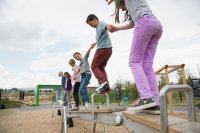Helping Refugee Students Feel Safe
Creating an environment of safety and security is crucial for inclusion of refugee students in the elementary classroom.
Your content has been saved!
Go to My Saved Content.A first grader spent the first two weeks in her new school hiding under her desk. When she finally emerged, she immediately attached herself to my leg. Any attempt to remove her ended in tantrums and tears. A classmate of hers greeted me every morning by dancing on his desk and shouting at the top of his lungs. He refused to sit in his seat and spent much of the day running around the room, hitting the other students and stealing from them.
The behavior I witnessed as a teacher of refugee children from conflict regions did not surprise me. I left Syria six months after the school where I taught was destroyed. Having experienced trauma firsthand, I knew the signs of post-traumatic stress experienced by refugee children. They often struggle to learn because the only thing they can think about is how to survive the next minute. Helping a student regain his sense of safety and security can improve the classroom environment for all students.
Respect Their Experiences
Sometimes we may not know if a child is a refugee because we may not even know what country or part of the world he came from. Students and families may hesitate to share their experiences of fleeing their home country because of racial, ethnic, or religious violence. While it would be easier for us to understand and predict the child’s behavior if we knew the details of the trauma that the child has suffered, we can use other methods to gain understanding.
When a child begins to talk about her experiences in conflict or other trauma, it may be a casual mention in conversation. Unfortunately, many refugee children have spent their entire lives in war, so it is their “normal,” and they talk about it as such. Mirroring the student’s approach will allow her to talk about events at her own pace. Accepting what the child says shows the child that you accept her and creates a sense of safety.
When I first went to Syria to teach, I taught English at the local Armenian community center and took Arabic lessons. Both gave me a new perspective on my students and a window into the community, and I became known as “the Syrian teacher.” Becoming a part of their community showed them that I truly cared about their children and broke down many barriers.
In working with refugee children, it can be valuable to familiarize yourself with their cultures. Trying a new restaurant or visiting a church or mosque can allow you to know people in the refugee and immigrant community. Taking the time and effort and demonstrating a willingness to learn shows the refugee community that you really care about their children.
Routines and Communication
When a young child who lives in an area of conflict kisses her parents goodbye in the morning, she doesn’t know if she will see them again when she comes home. In fact, she doesn’t know if she will have a home to come home to when school is out. Even the smallest change in classroom routine can put a refugee child into a tailspin. Establishing a clear routine offers security for all children and creates feelings of safety in the classroom.
While routine is important, don’t let it preclude some of the joy of spontaneity. Look for ways to marry classroom routine and spontaneity. For example, rather than using the buddy system on field trips, I keep my students together in the same teams I use in the classroom. The environment and activity may have changed, but there is still the predictability of the same faces.
It is quite likely that you are dealing with not only a child experiencing trauma but a whole family. Taking the time to touch base with parents and guardians to explain your classroom and after-school activities and to go over the school calendar helps make refugee families part of the school community. Schools may provide an interpreter or connect you with someone in the community who speaks the language. Alternatively, a translation app can be useful for facilitating a private conversation. Clear communication creates a sense of inclusion not only with the student but also with the family.
Show Compassion
I started a tradition with my primary students in Syria in which, when they were hurt or upset, I would kiss two of my fingers and gently brush them against the child’s cheek. Since they were just learning English, this simple gesture was a form of communication that they had no trouble understanding. In the fear and chaos of our final evacuation from the school, about 50 first and second graders crowded around me in the hall begging for “magic kisses.” My first reaction was to shout “No!” and chase them out to the buses and safety, but I quickly realized that giving in to my own frustration and fear would only make the situation worse. Instead, I passed out their magic kisses as fast as I could and watched them run for the bus with smiles on their faces.
For an English language learner, communication is often based on nonverbal cues. Start a welcome and farewell tradition, such as magic kisses or high-fives, that gives students a sense of belonging to begin and end the school day. For these children, survival has often depended on reading body language, so they may react strongly to anxiety or frustration. Maintaining a positive tone communicates that your classroom is a welcoming and inclusive space.
Our home, our country, is an essential part of our identity, and refugee children have often lost their connections to their home. Hearing from their teachers that they are wanted and loved can create stability and safety that allow them to flourish, in and out of the classroom.
